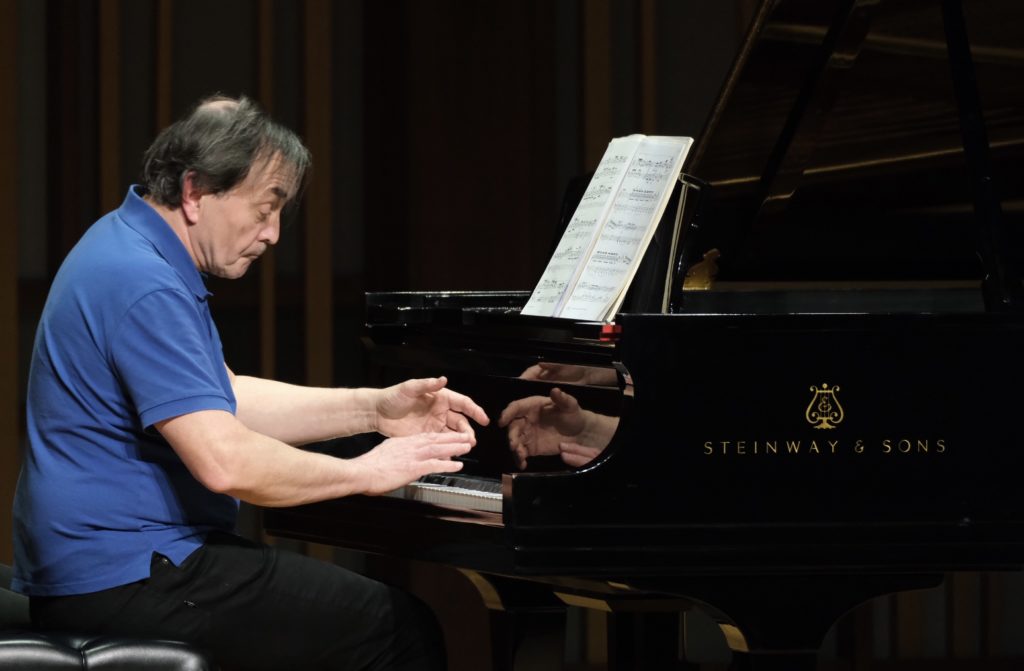Pianist Pierre-Laurent Aimard Offers a Festival of Fantasias at The Conrad
When the French pianist Pierre-Laurent Aimard walked out on The Conrad’s stage Sunday wearing slacks and a blue short-sleeve sport shirt, he quickly explained his unusual concert attire. After various flight cancellations because of the continent’s extreme weather, he finally did make his way to San Diego. His luggage, however, never left New York City.
His accidental unconventional attire, however, provided an apt symbol for his intentionally unconventional program, which was devoted exclusively to the fantasia. Especially popular in earlier musical periods, the fantasia has no formal constraints–its formula can be summed up in that bouncy title song from Cole Porter’s musical Anything Goes.When Aimard last performed for the La Jolla Music Society in March of 2018, his recital at the downtown San Diego Balboa Theatre gave an account of revolutionary piano music from the last two centuries, anchored in Beethoven’s landmark Hammerklavier Piano Sonata, Op. 106. Although Sunday’s festival of fantasias proved less probing than his previous recital, it proved an equally persuasive revisit of Aimard’s keyboard finesse. His unfailingly elegant touch and deft releases set him apart, whether he is playing sharp, brilliant attacks or a velvety, sonorous legato.
Aimard included all of Mozart’s four Fantasias on his program, opening with Fantasia No. 3 in D Minor, K. 397, a charming piece that begins in a somber minor mode but develops into a surprisingly cheerful major-mode instrumental aria that easily could have found its way into his later comic opera The Magic Flute. Mozart’s Fantasia in C Minor, K. 475, is composed of ample brash flourishes and excited themes that explore the extremes of the keyboard, as well as a tranquil section with repeated thick chords that presage Chopin’s familiar Prelude in E Minor. Mozart was responsible for the rhapsodic character of another C Minor Fantasy, K. 396, but he only started this flashy fantasy that his friend Maximillian Stadler completed after the composer’s demise. The Fantasy in F Minor, K. Anh 32, is just a fragment of jaunty, rapid themes that end abruptly because the composer never finished his project.
Aimard’s program offered not a single usual suspect, but his choices would certainly please the music history buff. He gave a convincing piano transcription of Jan Pieterszoon Sweelinck’s Fantasia Chromatica for organ, an early Baroque gem that moves from a serious chaconne to lively dance rhythms to a startling finale of extravagant flourishes. In C. P. E. Bach’s episodic Fantasia in C Major, H. 284, Aimard interpreted its effusive ornamentation and ample cross-hand display with affectionate ease. Beethoven’s Fantasia for Piano, Op. 77, offered the program’s most virtuosic challenges, a later in life echo of the composer’s youthful improvisatory genius.
I was highly engaged by Aimard’s 20th-century selections, Andrei Volkonsky’s 1956 Musica Stricta and George Benjamin’s 1985 Fantasy on Iambic Rhythm. A Russian composer who dared to write 12-tone music in the post-Stalinist Soviet Union, Volkonsky made himself persona non grata with his meticulously constructed, moving four-movement Musica Stricta. The tiny motifs of his second movement, an exhilarating atonal scherzo, bounced from one end of the keyboard to the other, and his reflective third movement shimmered gently in homage to the most austere works of Anton Webern. Ending a serial work with a toccata is no small feat—the genre’s typical moto perpetuo figures hardly fit the stringent rules of serial composition—but Volkonsky accomplished it handily, and Aimard brought his passionate sensitivity to this finely wrought composition.
The title of British composer Benjamin’s fantasy states its sole organizing principle—the use of the iambic rhythm for its major themes. Giving the pianist’s left hand a rumbling ostinato in the instrument’s lowest register allows the pianist’s right hand to sprinkle bright, contrasting motifs at the opposite end of the keyboard. Both the piece and the recital ended with a startling, spikey pair of chords, articulated in precise iambic rhythm, of course.
This recital was presented by the La Jolla Music Society on Sunday, February 26, 2023, in the Conrad Prebys Performing Arts Center in downtown La Jolla.

Ken Herman, a classically trained pianist and organist, has covered music for the San Diego Union, the Los Angeles Times’ San Diego Edition, and for sandiego.com. He has won numerous awards, including first place for Live Performance and Opera Reviews in the 2017, the 2018, and the 2019 Excellence in Journalism Awards competition held by the San Diego Press Club. A Chicago native, he came to San Diego to pursue a graduate degree and stayed.Read more…


Thank you, LJMS.